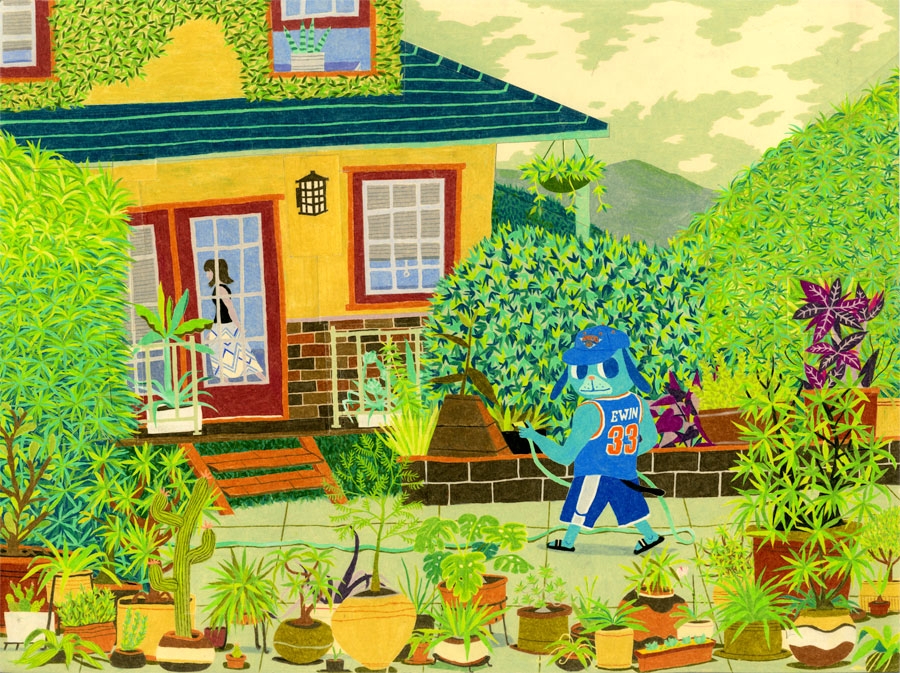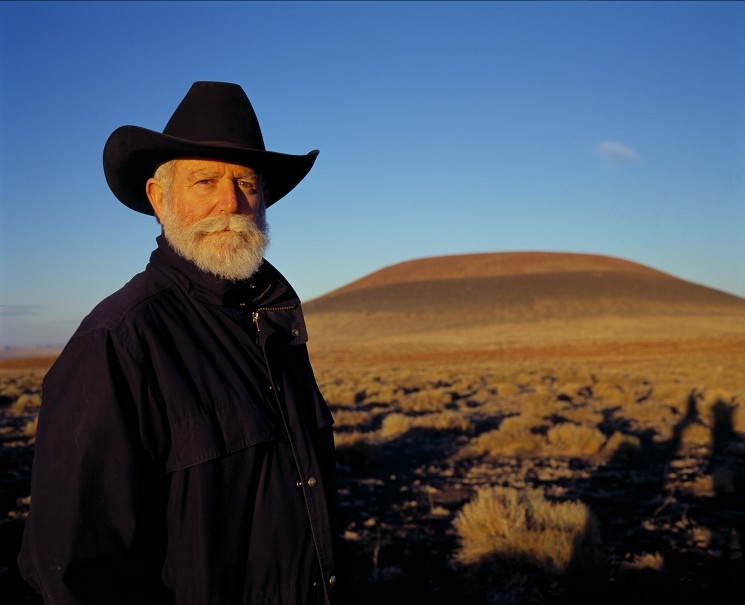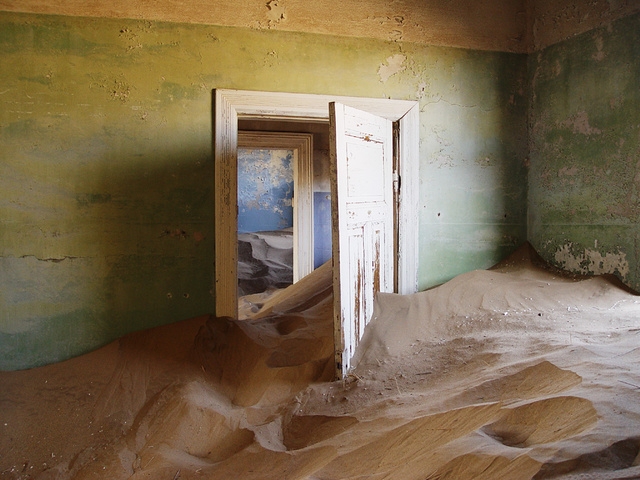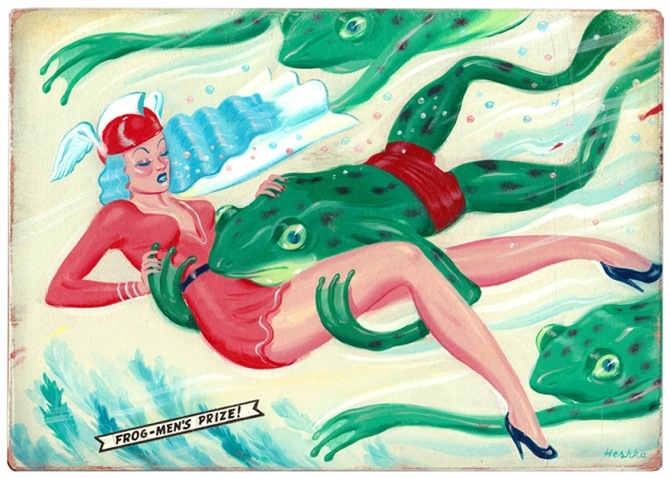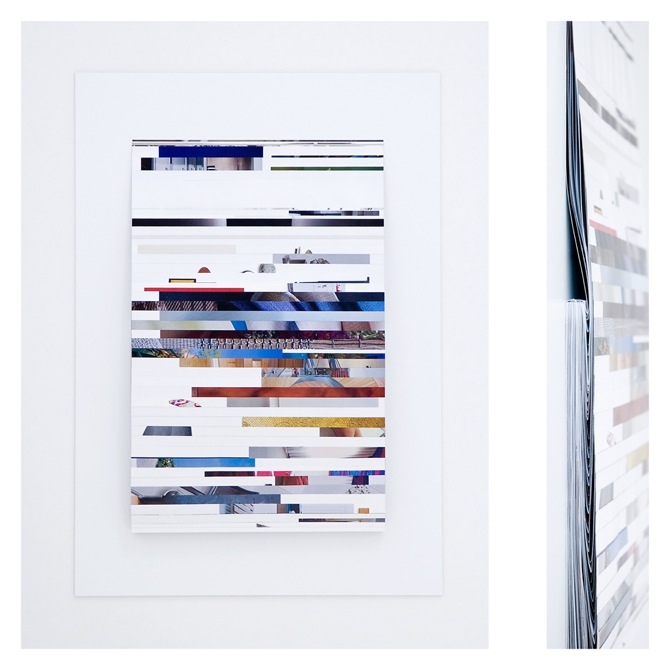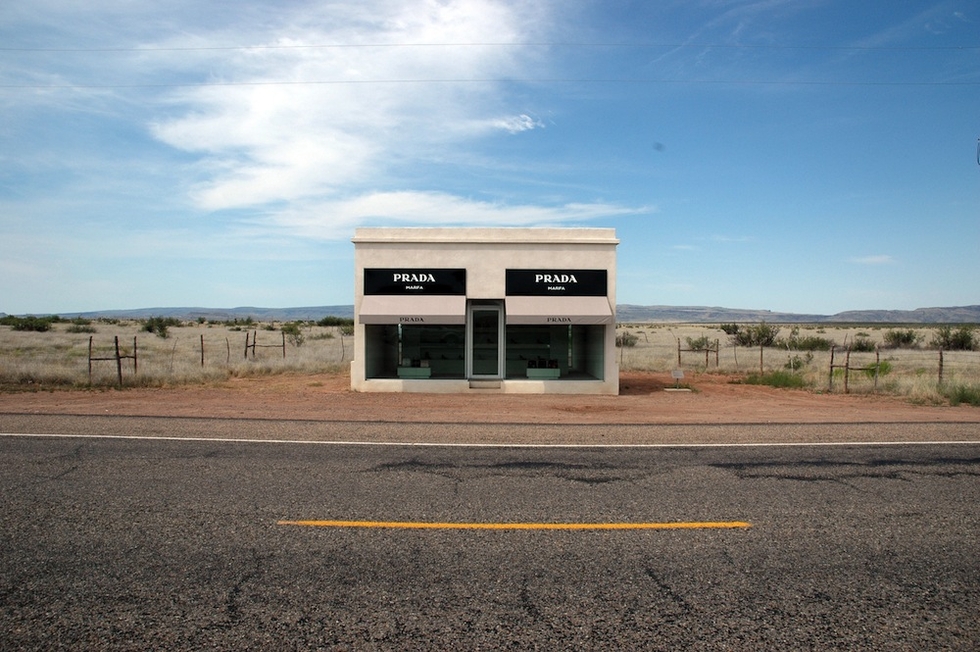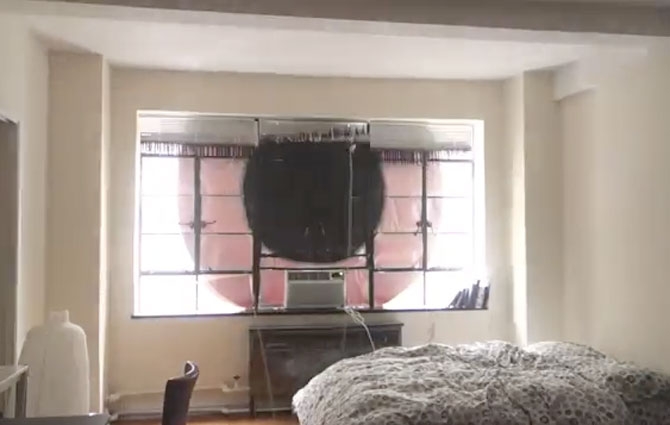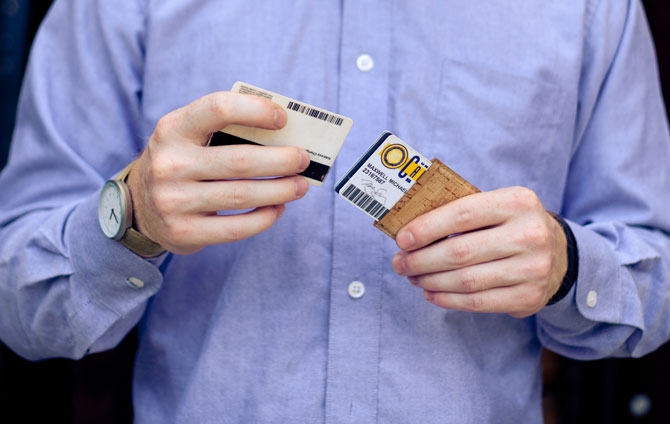While they are named for the Black Maria hearses that transported the corpses of coal miners during the early 20th century, the new sulfur-dyed denim from Left Field NYC likely isn't meant to be worn during long stings of hard labor—or by the dead. Rather, the black versions of the straight-leg Greaser jeans and slim-fit Chelsea jeans from Left Field will see us through hard times on the streets and in bars of our chosen cities. They've got a tough look. They're made in the USA from Japanese selvedge denim with a sulfur yarn-dyed warp and deep black weft. Complimenting the black-on-black weave are custom, all-black American tacks, rivets, and buttons, and red bandana pocket bags.
We're big fans of Andrew Ho's colored pencil illustrations. The California-based illustrator has a way of rendering the everyday activities of his anthropomorphized sports fan characters into vibrant scenes. Mundane activities like watering plants in a household garden or taking a nap on the couch easily become eye-catching scenes with Ho's eye for color and composition. We had to know more, so we emailed Ho some questions.
What's a typical day like? What time of day do you usually start working on illustrations?
Honestly, my days are inconsistent. I do not have a normal cycle by any means. For the most part, I work at night. There's something about the quiet and coolness of night that my mind really responds to.
What kind of materials do you work with?
I work with pencil. I have no secrets.

The brown and yellow striped upholstery in the Patrick Ewing fan's living room [Doubt] is pretty amazing. Can you talk a little about your work with color and texture? Seems like you intentionally want some things to clash.
When I make an image I always consider composition. When I draw one thing I will always consider things already existing within the image. Everything reacts to something else and equilibrium must be maintained. That aside, color, shapes, value are all considered in my process.

What projects are you working on now?
Currently, I'm working on a landscape drawing. Recently, I've been making drawings based off of some still lives, and I thought it might have been time to switch it up. So I've been studying various works from the Impressionists to the Hudson River School painters and I've been trying to implement some of their ideas into my work. It has been hard.
What's one place you'd love to see one of your illustrations? A bus? A billboard?
Honestly, the greatest place for my work would be in the possession of individuals who can appreciate what I have done. Knowing that my work is in the hands of someone who can value my labor is more than enough to grant me peace of mind.

There's a lot of sports imagery in your work. Is it hard being a Knicks fan in California?
That's funny. Um, well I don't have many friends that watch basketball with me and the few friends that I have are rather civil. We get into arguments here and there but it's all good fun. But believe me... we get into it.
See more from Andrew Ho at AndrewChuaniHo.com
In the world of art museums, James Turrell has been hard to miss this summer. He currently has major exhibitions open at the Guggenheim in New York, the Los Angeles County Museum of Art, and the Museum of Fine Arts, Houston. Put simply, Turrell’s medium is light. He creates indoor and outdoor spaces designed to demonstrate both the powers and limitations of human perception. As Turrell puts it, “My work has no object, no image, and no focus. With no object, no image, and no focus, what are you looking at? You are looking at you looking. What is important to me is to create an experience of worldless thought.”
To pique your interest, here are five of our favorite Turrell works:
 Hard Scrabble Sky
Hard Scrabble Sky
In the midst of the University of Illinois, Chicago’s campus, Turrell created one of his signature “Skyspaces”—a structure with an opening at the top that obscures the horizon, allowing viewers inside the elliptical structure to observe the ever-changing light and sky patterns through the roof above them.
 Stone Sky
Stone Sky
This 2005 work at a private home in Calistoga, CA combines one of Turrell's Skyspaces with an infinity pool. The large square at the end of the pool holds the Skyspace, accessible by swimming underwater at the end of pool. The interior is lined with teak and a square opening at the top opens the structure to the sky.

End Around
Many of Turrell’s works focus on enhancing the experience of looking at the sky or the natural world, but works from his Ganzfeld series use electric light to challenge the power of our eyes. "End Around" (2006) is currently being shown at the Museum of Fine Arts, Houston, and like his other Ganzfeld series works, "End Around" simulates a total loss of depth perception. The viewer is bathed in a field of blue light and, at some point, the light almost becomes a physical presence because of the loss of depth perception.

Roden Crater
Turrell has been working on this massive space in a natural cinder cone volcano in Arizona since 1972. Turrell’s site picks up on the ancient tradition of creating manmade monuments to view celestial events, with different rooms heightening the viewer’s perception of sunrise, sunset, the stars, and natural light. Roden Crater combines Turrell’s explorations of light and perceptual science into one unique site in Arizona’s Painted Desert but, unfortunately, it’s not open to the public (yet).
Perceptual Cells
These works are Turrell’s most intense. He’s been creating these types of immersive pieces since the late '80s, and there’s at least one on view at LACMA this summer. In a Turrell Perceptual Cell, the viewer enters a small, enclosed space alone to experience an intensely bright light that slowly changes over the course of the visit. Most viewers describe the experience as somewhat hallucinatory, while some find it too unsettling to view twice.
It's a misconception that all ghost towns were once thriving cities. The traditional narrative of the ghost town, in wich cities are suddenly emptied by war, economic pressure, or an environmental catastrophe, now includes new varieties with bizarre political backstories.
Pyramiden, a remote coal mining city was built by Sweden in 1910 on Svalbard, the Norwegian archipelago next to Greenland. The city, sold to the Soviet Union 17 years after its construction and shuttered in 1998, now stands preserved with its full basketball courts and schools completely empty. It has inspired at least one album by a member of Peter Bjorn and John. And Efterklang went so far as to record an album there.
In Angola, Kilamba New City is a massive real estate development built by a state-owned construction company from China, and paid for with oil exchanges. Currently, it's largely unoccupied, but has the capacity to house half a million residents and boasts 750 apartment buildings. 
The pop star who once proudly told us she was a material girl, now stands for global freedom of expression. This month, she launches her Art for Freedom, an online initiative to further change via artistic creation. The project, created by Madonna herself and curated by VICE, will be distributed by BitTorrent—that's right, one of those file-sharing networks where one used to be able to nab bootlegs from the Virgin tour.
Madonna's secretprojectrevolution film, a 17-minute film she co-directed with Steven Klein, will be distributed as a BitTorrent Bundle on the network. The film, plus bonus content, is free to download beginning September 24 at 2pm EST at bittorrent.com
"I hope my film and other submissions to Art For Freedom will be a call-to-action and give people a place to voice their own creative expression to help fight oppression, intolerance, and complacency," says Madge.
The global, digital platform won't just be for Guy Ritchie's exes, however. Creative members of the public will be able to submit to the Art For Freedom platform by uploading original artwork or tagging their posts #artforfreedom. In other words, most content will be crowd-sourced, with VICE presumably pushing the good bits to the top.
Is this platform made to last; is it going to amount to anything at all? It's hard to say—we'll check again post-launch.
Canadian magazine illustrator Ryan Heshka actually trained in interior design, but it seems the self-taught illustrator found his true inspiration in pulp mags, classic comic styles, and graphic design. His show "Strange Powers III" just opened, featuring 16 paintings from a forthcoming BLAB! trading card set of money-grubbing zombies, a multi-tentacled death, and slime-drooling creatures.
The show runs to November 5 at Copro Gallery.



Gemis Luciani's meticulous collages take the paper detritus meant for the recycling bin and turns it into incredible sculptures. Some of his pieces are carefully folded and hung design magazines; others are made from the often annoying but sometimes useful bit of near obsolescence, the telephone book.
Triangulation has more info on individual pieces.





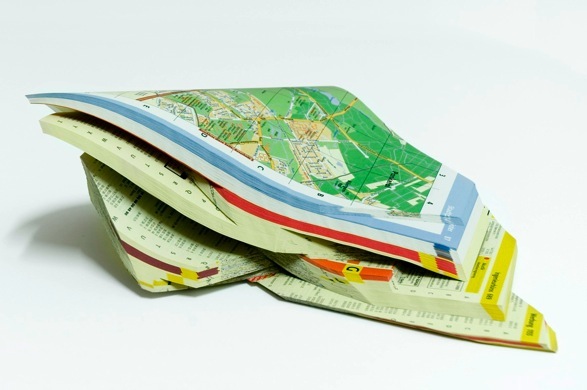

Prada Marfa, the undisputed most interesting Prada store in the world, has a uncertain future thanks to anti-advertising legislature passed four decades ago by Lyndon B. Johnson and Lady Bird Johnson. The law, the 1965 Highway Beautification Act, prohibits advertising on certain stretches of Texas highways, including U.S. 90, the highway Prada Marfa has been installed beside for about eight years by artists Michael Elmgreen and Ingar Dragset.
Local authorities have ruled that the installation is actually a Prada ad, and not a piece of art using the Prada logo. The New York Times points out that the store has Prada's blessing, and its inventory of modified Prada bags and shoes were chosen and donated by the company. The installation however, doesn't receive any financial support from the fashion brand, and was instead funded by two nonprofits, the Art Production Fund in New York and the local Ballroom Marfa.
Apparently, Prada Marfa's legal problems started earlier this summer when Playboy Magazine paid for an advertisement featuring a neon version of their bunny logo a few miles away, clearing violating the same Highway Beautification Act.
Taiyo Kimura's video for Superchunk's hardcore-inspired tune "Staying Home" is a bizarre, low-tech, and kind of gross (as in the eating curry and rice from the toilet in a Mac mask bit) clip, but a perfect fit. Mac McCaughan encountered Kimura's work at a gallery show in Durham, NC, hung out with him in Tokyo, and eventually approached him about doing a video for a tune from the new I Hate Music. In an ART INFO post, McCaughan says of Kimura, “He always manages to do this thing in videos where you kind of think you know what you’re looking at, then you realize you’re not sure what you’re looking at.”
If you've been wondering why designers have taken to cork so heartily in recent years, the Kickstarter page for the Subrr wallet sumarizes its benefits well. "Cork is as durable as leather but water resistant, and harmless. Cork oak intakes 5x more CO2 when regenerating harvested bark." California's Subrr has a Kickstarter campaign going for the wallet, available in two versions and two types of cork. The designs themselves, each hold up to 10 cards and one version has three compartments, also encourage simplicity—basically you can't carry more than you need. They've also got a cork iPhone back—available through the same campaign.
Support the Subrr wallet now on Kickstarter.



